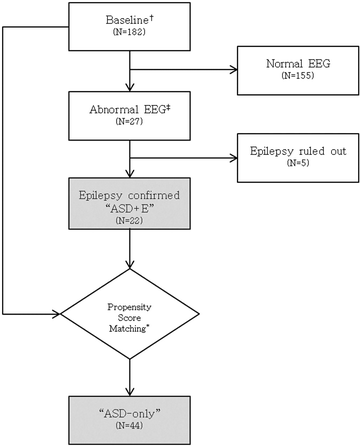The effect of epilepsy on autistic symptom severity assessed by the social responsiveness scale in children with autism spectrum disorder
- PMID: 27350381
- PMCID: PMC4924297
- DOI: 10.1186/s12993-016-0105-0
The effect of epilepsy on autistic symptom severity assessed by the social responsiveness scale in children with autism spectrum disorder
Abstract
Background: As the prevalence of autism spectrum disorders in people with epilepsy ranges from 15 to 47 % (Clarke et al. in Epilepsia 46:1970-1977, 2005), it is speculated that there is a special relationship between the two disorders, yet there has been a lack of systematic studies comparing the behavioral phenotype between autistic individuals and autistic individuals with epilepsy. This study aims to investigate how the co-occurrence of epilepsy and Autism Spectrum Disorder (ASD) affects autistic characteristics assessed by the Social Responsiveness Scale (SRS), which has been used as a measure of autism symptoms in previous studies. In this research we referred to all individuals with Autism or Autistic Disorder as individuals with ASD.
Methods: We reviewed the complete medical records of 182 participants who presented to a single tertiary care referral center from January 1, 2013 to July 28, 2015, and subsequently received complete child and adolescent psychiatric assessments. Of the 182 participants, 22 were diagnosed with Autism Spectrum Disorder and epilepsy. Types of epilepsy observed in these individuals included complex partial seizure, generalized tonic-clonic seizure, or infantile spasm. Using 'Propensity Score Matching' we selected 44 children, diagnosed with only Autism Spectrum Disorder, whose age, gender, and intelligence quotient (IQ) were closely matched with the 22 children diagnosed with Autism Spectrum Disorder and epilepsy. Social functioning of participants was assessed by the social responsiveness scale, which consists of five categories: social awareness, social cognition, social communication, social motivation, and autistic mannerisms. Bivariate analyses were conducted to compare the ASD participants with epilepsy group with the ASD-only group on demographic and clinical characteristics. Chi square and t test p values were calculated when appropriate.
Results: There was no significant difference in age (p = 0.172), gender (p > 0.999), IQ (FSIQ, p = 0.139; VIQ, p = 0.114; PIQ, p = 0.295) between the two groups. ASD participants with epilepsy were significantly more impaired than ASD participants on some measures of social functioning such as social awareness (p = 0.03) and social communication (p = 0.027). ASD participants with epilepsy also scored significantly higher on total SRS t-score than ASD participants (p = 0.023).
Conclusions: Understanding the relationship between ASD and epilepsy is critical for appropriate management (e.g. social skills training, seizure control) of ASD participants with co-occurring epilepsy. Results of this study suggest that mechanisms involved in producing epilepsy may play a role in producing or augmenting autistic features such as poor social functioning. Prospective study with larger sample sizes is warranted to further explore this association.
Keywords: Autism spectrum disorder; Autistic symptom severity; Epilepsy; Social responsiveness scale.
Figures

References
-
- Association AP. Diagnostic and statistical manual of mental disorders (DSM-5®): American Psychiatric Pub. 2013. - PubMed
-
- Fisher RS, van Emde Boas W, Blume W, Elger C, Genton P, Lee P, Engel J., Jr Epileptic seizures and epilepsy: definitions proposed by the International League Against Epilepsy (ILAE) and the International Bureau for Epilepsy (IBE) Epilepsia. 2005;46:470–472. doi: 10.1111/j.0013-9580.2005.66104.x. - DOI - PubMed
MeSH terms
LinkOut - more resources
Full Text Sources
Other Literature Sources
Medical
Research Materials

